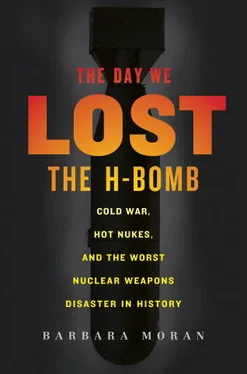Sensing impatience from Washington, LeMay devised a daring plan for the March 9 mission. He would send the bombers in at night at a low altitude — under 10,000 feet — to avoid the jet stream and surprise the Japanese. If a bomber didn’t have to fight the jet stream, LeMay calculated, it would use about two and a half tons less fuel. And he could save an additional two tons by stripping the planes of most of their guns, gunners, and ammunition. These two changes — flying at low altitudes and basically unarmed — would allow each plane to double its payload and drop bombs more accurately.
It would also put the pilots at greater risk from Japanese antiaircraft fire, but LeMay concluded that it was a fair gamble. The Japanese air defenses were weaker than those he had seen in Europe. He thought his pilots could pull it off.
LeMay was used to tough decisions, but this was one of the toughest. If this strategy worked, it could shorten the war and maybe prevent an invasion of Japan. But if he had miscalculated, he would be sending hundreds of young men on a suicide run. On the night of March 9, after seeing the planes off, the mission weighed heavy on his mind. At about 2 a.m., an Air Force PR officer named St. Clair McKelway found LeMay sitting on a wooden bench beneath the mission control boards.
“I’m sweating this one out,” LeMay told McKelway. “A lot could go wrong. I can’t sleep. I usually can, but not tonight.”
LeMay knew that there was much at stake: his reputation, the lives of all those men, possibly the outcome of the war. But something else hung in the balance, too — the future of an independent Air Force.
When World War II began, there was no such thing as the U.S. Air Force. Planes and pilots served under the U.S. Army Air Forces (USAAF), which provided firepower, transport, and supplies — what’s called tactical support — to Army troops on the ground, where the real fighting was going on.
The airplane was just another tool for ground warfare, and it had no mission or role beyond what the Army assigned it.
To airmen, however, the airplane wasn’t just a glorified school bus or food truck, it was a machine that could change the face of warfare. But they knew airpower could never reach its full potential under Army generals. They wanted their own service, with their own money, their own rules, and airmen in charge. To make a legitimate claim for independence, they had to prove that they were indeed different and offered a valuable skill that the Army and Navy lacked. That skill, most agreed, was long-range strategic bombing.
Strategic bombing can be a bit hard to distinguish from tactical bombing, because the two often overlap. But in general it means dropping bombs on key bits of enemy infrastructure — oil refineries, engine plants, important bridges — that aren’t directly involved in a current battle but greatly affect the enemy’s ability to fight. In 1921, an Italian general named Giulio Douhet first defined strategic bombing in his book The Command of the Air . Douhet’s idea gained popularity between World War I and World War II but faced some resistance. For Douhet, strategic bombing meant that an entire country was fair game; planes could target hospitals and food depots as legitimately as airstrips and factories. There were few safe havens, no noncombatants. Bombing city centers could crush the will of the civilian population, argued Douhet, forcing enemy leaders to surrender quickly and leading to less bloodshed in the end. American airmen, wary of civilian casualties, advocated bombing specific targets to disable the enemy’s economy. Even so, critics called such tactics uncivilized, immoral, and un-American. Outside airpower circles, the idea fizzled.
Then came World War II, and the Army Air Forces saw their chance. They argued for the opportunity to bomb German train yards and oil refineries, and they got it. And it was true that the airplanes offered something that Navy ships and Army tanks couldn’t: only airborne bombers could fly deep into Germany, destroy German factories, and break the German war machine. That is, if the bombers could actually get to Germany and manage to hit anything.
In the early days of World War II, an assignment to a bomber crew was nearly a death sentence. The lumbering B-17 Stratofortresses flew in large, rigid formations, easy targets for enemy fighters and flak. Bombers flying from England to Germany sometimes had fighter escorts, but the fighters had such a short range that they usually turned back at the border of Germany, leaving the bombers to face the most risky portion of the journey alone. Bomber groups sometimes lost half — or more — of their planes on raids over Germany. In one infamous circumstance, the 100th Bomber Group lost seven planes over Bremen on October 8, 1943. Two days later, it lost twelve of its remaining thirteen planes over Munster. Bomber crews were more likely than foot soldiers to be killed, wounded, or captured. Twice as many air officers died in combat as those on the ground, despite their smaller numbers. An airman in a World War II bomber had a shorter life expectancy than an infantryman in the trenches of World War I.
After reading accounts of air battles, such statistics seem less surprising. On August 17, 1943, German fighters attacked a division of American B-17 bombers over Belgium. An observer in one of the rear planes later described the battle:
A stricken B-17 fell gradually out of formation to the right, then moments later disintegrated in one giant explosion. As the fighters kept pressing their attacks, one plane after another felt their fury.
Engine parts, wing tips, even tail assemblies were blasted free. Rearward planes had to fly through showers of exit doors, emergency hatches, sheets of metal, partially opened parachutes, and other debris, in addition to human bodies, some German, some American, some dead, some still alive and writhing. As more German fighters arrived and the battle intensified, there were so many disintegrating airplanes that “sixty ’chutes in the air at one time was hardly worth a second look.” A man crawled out of the copilot’s window of a Fortress engulfed in flames. He was the only person to emerge. Standing precariously on the wing, he reached back inside for his parachute — he could hardly have gotten through the window with his chute on — used one hand to get into the harness while he clung to the plane with the other, then dove off the wing for an apparently safe descent, only to be hit by the plane’s onrushing horizontal stabilizer. His chute did not open.
The passage comes from Iron Eagle , Thomas Coffey’s biography of Curtis LeMay. LeMay, head of the 4th Bombardment Wing in England at the time, flew in the lead bomber. Until his superiors forbade it, LeMay often accompanied his men on bombing missions, a habit that inspired deep trust and loyalty among his flyers. LeMay also inspired fear, or at least trepidation. Stocky, square-jawed, and perpetually chewing a cigar, he was a tough guy who looked the part. He scowled often and spoke little. Decades after the war, LeMay’s gruff demeanor and blunt, often tactless public statements would make him the object of widespread derision and caricature. But here, in World War II, he was in his element. He got things done.
LeMay hated the thought of being unprepared, of losing men and bombers because of poor training or sloppy mistakes. When he arrived in England, he was alarmed by the rabble the Army gave him — rookie airmen who could barely fly a plane or bomb a target. These kids would die unless he whipped them into shape. And whip them he did. His men called him “Iron Ass” for his relentless training regimen — exhausted pilots would return from a bombing run ready for bed, only to be ordered back in the plane to practice bad weather takeoffs. Bombardiers had to memorize stacks of photographs in preparation for future missions. LeMay worked as hard as his troops, becoming a brilliant strategist. During his time in Europe, he devised new flying formations and bombing techniques that saved bombers and helped pick off German factories. On August 17, 1943, the day of the mission described in the passage above, the surviving B-17s flew to Regensburg and dropped 303 tons of bombs on a Messerschmitt aircraft plant, one of the most accurate strategic bombing runs of the war.
Читать дальше











